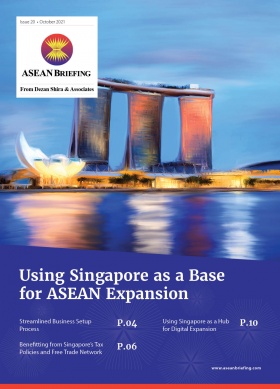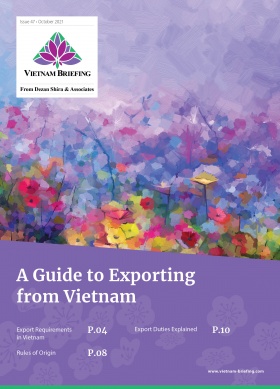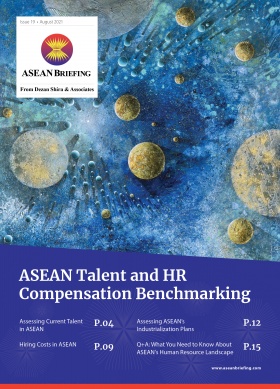Why the Agtech Industry Will Aid Vietnam’s Hi-Tech Growth
Agriculture is an important economic sector in Vietnam. In 2020, agriculture, aquaculture, and forestry sectors contributed 14.9 percent to Vietnam’s GDP, which is lower than 41.6 percent of the service and 33.7 percent of the industry sector. Although agriculture has doubled in terms of value in the last decade, its share in GDP has witnessed an average annual decrease of 0.3 percent.
Science and technology are key to increasing the capacity and quality of products while improving farmer lives. Vietnam’s government in 2018 stated that it was important to develop a production value chain of high-added value farming products while promoting the link of cooperatives with businesses, as well as to encourage technology transfer and provide preferential loans to agricultural cooperatives.
This is where agricultural technology (Agtech) comes in. Agtech is the use of technology in agriculture with the aim of improving yield, efficiency, and profitability. Agtech can be products, services, or applications that come from agriculture that improve various input/output processes
Vietnam’s agtech industry is still behind other countries despite being an agricultural country. Given a large number of small-hold farmers, in contrast, there are limited agtech companies and projects in Vietnam. Agtech is a relatively unknown concept in Vietnam’s rural areas. While in more developed economies like the Netherlands, Australia, and Israel, technology has been integrated into agriculture for years; it is still challenging to integrate modern technology into Vietnam’s agricultural sector.
The government views biotechnology, automation, mechanizing technology, and information technology as fundamental to implementing sustainable agricultural practices, increasing productivity. Agtech could be a major boon for the green economy of Vietnam.
Vietnam has 12 areas certified for hi-tech agriculture. The three most prominent zones are Hau Giang, Phu Yen, and Bac Lieu provinces. The State Bank of Vietnam (SBV) along with commercial banks have also offered a financial package of VND 100 trillion (US$4.37 billion) to support enterprises applying high-tech farming.
There are more than 20 enterprises in the Central Highlands in Vietnam that have applied agtech in their operation and farming including IoT, big data, blockchain, plant growth monitoring cameras, environmental sensors, and greenhouses with automatic adjustment systems linked with computers and smartphones, LED light, smart GIS pest management, prediction systems, and electronic traceability.
Foreign agricultural firms also play a crucial role in promoting the agtech sector in Vietnam. Bayer Global (Germany), Charoen Pokphand (Thailand) are becoming strategic investors in local agricultural companies. Charoen Pokphand (C.P.), a Thai conglomerate, has worked on accurate data and applied automation in farming. C.P has also supported its partners that are small farming households and cooperatives in terms of technology to guarantee the quality standard of livestock and aquaculture output.
Market drivers for Vietnam’s agtech industry
Since reforms in 1990, the Vietnamese government has shifted Vietnam toward a more market-oriented economy. The national GDP tripled in value from 2008 to 2019. Economic growth momentum remained strong and stable with a CAGR of 6.0 percent during this period. As with other global economies affected by the COVID-19 pandemic, Vietnam’s economy suffered significantly throughout the outbreak in 2020. In 2021, Vietnam’s economy is expected to recover to its normal pace. Aside from these, we examine some market drivers for Vietnam’s agtech industry.
Labor productivity
As the government’s priority was national food security in which rice played a dominant role in the 1990s, the abundant labor force provided reliable resources contributing to sector growth as well as labor-intensive requirements. Since the macrostructure has shifted toward industrial and service sectors, the labor force in agriculture has shrunk in the past decade.
The average age of farmers has risen markedly. Additionally, Vietnam’s labor productivity was among the lowest in the region at only 1/18th of Singapore’s despite growth. The education and qualification level of the labor force is still relatively low. This trend has led to increased application of agricultural technology to compensate for output loss from crops and livestock/aquaculture.
Unstainable agricultural development
By the early 1990s, Vietnam was becoming a major exporter of agricultural and aquaculture products. However, Vietnam faces a dilemma: food security or economic growth. To achieve high economic growth and economic efficiency, Vietnam needs to emphasize a rapid urbanization and industrialization rate together with crop diversification. This will lead to a reduction in the arable land area and risk of long-term food security since rice is a staple crop in Vietnam.
In order to tackle these issues, Vietnam needs to build a more sustainable ecosystem to ensure national food security and the quality of agricultural products. This indicates the demand for more sustainable systems and new technologies that are non-toxic and environmentally friendly.
Opportunities
There is an increasing trend of Vietnam cooperating with other developed countries in agtech. The Ministry of Agriculture and Rural Development (MARD) in Vietnam has signed several Memorandum of Understanding (MoUs) with developed countries such as Japan, Ireland, the Netherlands, and Australia to learn experiences from high technology-based agricultural systems.
In terms of the private sector, some local enterprises have collaborated with foreign firms and institutions in the form of technology and technology transfer, investment, training, and mutual product development. These local firms are mainly big corporate farms’ practices or conglomerates that are financially capable of investing in new agricultural technology.
Opportunities for foreign enterprises lie in partnership with agricultural companies who wish to transform their farms to high-tech farm or to find new technology to improve their current capacity.
Some of the most promising opportunities include the Internet of things, smart farming, machinery and software, genetic and breeding, and pest management. Low cost, simplicity, and efficiency will enable companies to succeed in the agtech sector in Vietnam.
Internet of Things
Both foreign and domestic firms are interested in investing in the Internet of Things (IoT) and blockchain because the barrier to entry and investment is relatively low. Farmers only need access to smartphones, electricity, and internet connectivity along with the equipment which is already in their farms.
Vietnamese farmers are mainly small farming households, thus, affordable and adaptable solutions to increase production efficiency without significant investment are the top priority.
There are some local startup firms in agtech that have been applying some elements of agriculture 4.0 that are intelligent applications and devices. For example, MimosaTEK, one of the most successful startup agtech companies, has provided IoT-based management services to build an information platform to improve the livelihoods of farmers by transforming experience-based farming activities into information-driven activities.
Sensors installed at farms collect and update data related to moisture, light, temperature, fertilizing, and other factors onto a cloud platform. Then, the automated system will allow the farmers to optimize water, electricity, and fertilizer usage, achieve optimum crop yield and provide full traceability to their commercial partners.
There is significant potential in this sector for foreign investors due to the simplicity of integrating IoT products/services to current farming systems that have already existed.
Foreign firms may face competition with local companies since most agtech startup firms are operating within this subsector. Domestic firms have more advantages in terms of proximity to the customers and understanding of the local market.
Smart farming
Opportunities for foreign investors in agtech are farm management package solutions for both large-scale companies and small farmers. Also, there are opportunities for agricultural services and consulting related to animal husbandry, food safety, and quality assurance.
Some foreign investors that are eyeing this sector in Vietnam include Enzootic (Israel and Hong Kong), GoodHout BV, SmartFarm Co Ltd, and FairAgora Asia (Thailand), GAGO (China), Intello Labs (India), Pycno Industries (Australia), Gintel (Taiwan), and Fluence corporation-NIROBOX (Israel).
Foreign companies may take longer to enter the market since smart farming requires a comprehensive approach from seed technology, production, harvesting, post-harvest storage, and transport. The agricultural market is highly fragmented, so the application of farming management can be fraught with challenges.
Machinery and software
Foreign companies that supply robotics, machinery, and equipment that are used to automate farm work, should look for opportunities to partner with local corporations. For example, in the dairy sector, comprehensive automatic control production lines, advanced technology, and equipment are imported from developed countries such as Sweden, Denmark, Italy, and Switzerland. This ensures the quality and quantity of output.
Vietnamese enterprises, such as TH True Milk or Vinamilk with substantial financial capacity and large production scale, have invested billions of dollars in hi-tech farming. The grasslands are farmed with automatic watering machines and soil tillers.
Due to high capital injection involving large-scale capabilities and high levels of commitment and management, partner opportunities are limited to mainly larger corporations. The risks of financial failure, unforeseen environment, and market circumstances have made small and medium enterprises reluctant to invest in machinery and software. For example, only about 500 farms on over 10 ha in Vietnam use equipment from smart fertigation machines. This is due to the cost which ranges from US$10,000 to US$15,000 making the market size small.
Genetics and breeding
As biotechnology has played a significant role in transforming Vietnam’s agricultural sector the government has pushed forward strategies to make Vietnam’s biotechnology industry one of the leading industries in the region. Vietnam has made some advancements in gene technology in selecting and creating species of crops and livestock, which have high yields, are of good quality, and are resistant to diseases.
Since the government has put more focus on R&D and the application of biotechnology to improve the quality of seeds and animal breeds, opportunities for foreign enterprises in this sector is to partner with several institutes, universities, and startups for research-based agriculture productivity.
Genetic and breeding are highly distinct to the characteristics of the crops in Vietnam. Thus, foreign companies may need to invest in advanced training and R&D processes to characterize the markets. For example, Vietnam needs rice varieties that are tolerant and resilient to adverse conditions.
Regulations governing agtech
While the Vietnamese government has favorable policies and regulations to promote the application of high tech in the agriculture sector foreign firms may face several issues. The first issue is lengthy procedures to import supply chains and equipment to Vietnam. The second issue is the lack of transparency in incentives, environment regulations, and poor management of agricultural input and output. This results in challenges for foreign firms that have to navigate their strategies when expanding to Vietnam.
Government agencies
Three government bodies that have a significant impact on agtech regulation and direction are:
- Ministry of Agriculture and Rural Development (MARD) is a government ministry responsible for rural development and the governance, promotion, and nurturing of agriculture and the agriculture industry, in Vietnam. MARD issued a resolution on continuing to promote science and technology innovation activities in agriculture and rural development in the context of economic integration and approaching Industry 4.0.
- The Ministry of Industry and Trade (MoIT) is the government ministry in Vietnam responsible for the advancement, promotion, governance, regulation, management, and growth of industry and trade.
- The Ministry of Health is the government ministry responsible for the governance and guidance of the health, healthcare, and health industry of Vietnam.
Certificate of hi-tech agricultural enterprises
Dossiers of application for a certificate of the hi-tech agricultural enterprise shall be filed directly with or sent by post to the Ministry of Agriculture and Rural Development. A dossier, which has to be made in one original set and one copied set, comprises:
- An application for recognition of a hi-tech agricultural enterprise made according to a form set by the Ministry of Agriculture and Rural Development:
- A notarized copy of the enterprise’s business registration certificate or investment certificate or certificate of the scientific and technological enterprise; and
- A written explanation about the enterprise’s satisfaction with the conditions.
The model certificate of the hi-tech agricultural enterprise shall be issued by the Ministry of Agriculture and Rural Development.
Government incentives
The government issued Decree 57/2018/ND-CP on incentive policies for both domestic and foreign-invested enterprises investing in agriculture, and the rural development sector. The decree takes into account state support for land, credit access, high-tech application, and workforce training. The projects eligible for this incentive will be exempted from land and water surface rents in the first 15 years and a 50 percent reduction in the following seven years.
Tax incentives
Investors are eligible for a CIT of 10 percent (normally 20 percent) if they satisfy the following conditions:
- Income of a company from the execution of a project of investment in manufacturing, except for manufacturing of products subject to special excise tax and mineral extraction, the capital investment in which is not smaller than 12,000 billion VND (US$522,000), the technologies applied are assessed in accordance with the Law on High-technology, the Law on Science and Technology, and the registered capital is disbursed within five years from the day on which the investment is permitted as prescribed by regulations of law on investment.
- Income from a company from planting, cultivating, protecting forests; cultivating, processing agriculture and aquaculture products in a disadvantaged area; producing forestry products in a disadvantaged area; producing, propagating, cross-breeding plants and animals; producing and refining salt, investment in the preservation of harvested farm produce, preservation of agriculture products, aquaculture products, and foods
- Preferential tax rate of 15 percent for income of cultivation, husbandry, and processing enterprises in the fields of agriculture and fisheries not in difficult or extremely difficult areas.
- A tax rate of 10 percent for 15 years, tax exemption of not more than four years, and 50 percent reduction of payable tax amount for no more than nine subsequent years for enterprise’s income from implementing new investment projects at areas with extremely difficult socio-economic conditions.
- A tax rate of 17 percent for 10 years, tax exemption of not more than two years, and 50 percent reduction of payable tax amount for no more than four subsequent years for the enterprise’s income from the execution of new investment projects. in areas with difficult socio-economic conditions.
- In addition, the enterprise earning income from the production of and trade in science and technology products shall be entitled to the same remission of CIT as those applied to enterprises running new scientific research and technology development projects. To be specific, tax exemption for four years and 50 percent tax reduction for the next nine years. It is important to note that the tech firm shall not be entitled to remission of CIT in the fiscal year if the revenue from the production of and trade in science and technology products in such year fails to account for at least 30 percent of its total revenue.
About Us
ASEAN Briefing is produced by Dezan Shira & Associates. The firm assists foreign investors throughout Asia and maintains offices throughout ASEAN, including in Singapore, Hanoi, Ho Chi Minh City, and Da Nang in Vietnam, Munich, and Esen in Germany, Boston, and Salt Lake City in the United States, Milan, Conegliano, and Udine in Italy, in addition to Jakarta, and Batam in Indonesia. We also have partner firms in Malaysia, Bangladesh, the Philippines, and Thailand as well as our practices in China and India. Please contact us at asia@dezshira.com or visit our website at www.dezshira.com.
- Previous Article Why Use Singapore as a Base for ASEAN Expansion
- Next Article Singapore Issues New Supply Chain Initiative to Help SMEs






